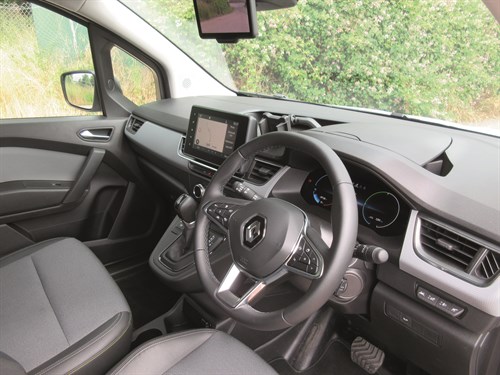- Further 4.25t electric van rule changes under consideration
- Arval research uncovers van fleet optimism
- Pre-orders open for new Nissan Interstar
- More than half of UK van drivers now believe EVs more cost effective than ICE, VW finds
- Public EV charging costs preventing adoption for some fleets, AFP says
- Ford Ranger Tremor review
- Inseego awarded Crown Commercial Service framework status
- ADVERTISEMENT FEATURE: Electrify and optimise: Digital solutions at the forefront of decarbonisation
- Fleets being pushed to take electric vans due to ZEV mandate, AFP reports
- Buying a used... Citroen Relay (2019)
The What Van? Road Test: Renault Kangoo E-Tech (2022)
Date: Tuesday, August 29, 2023

Interior and equipment
Fitting an interior rear-view mirror is pointless if you have an opaque bulkhead, so Renault decided to equip our demonstrator with an optional camera that shows what is behind you at all times. The picture is shown on a dedicated screen.
Initially we felt it was distracting, but we soon got used to it and appreciated its clarity.
At a cool £800, however, – all prices quoted here exclude VAT – the price is eye-watering. So, it would be understandable if buyers decided to rely solely on the heated, electrically-adjustable, exterior rear-view mirrors instead.
That said, do not forget the wide-angle mirror mounted on the inside of the sun visor. It should enable you to spot a cyclist who would otherwise be invisible edging down your nearside.
The aforementioned camera is separate to the reversing camera – another option – that delivers a different, close-quarters, image to the touchscreen in the centre of the dashboard. The reversing sensors that complement it are standard.
The 8.0in Easy Link touchscreen controls the infotainment system, with Bluetooth connectivity, Android Auto, Apple CarPlay and a DAB radio all present, along with a 12-volt power socket and USB ports. Our test van boasted an optional smartphone dock.
Remote controls for the radio are housed on a small stalk on the steering column that can be quite difficult to see when you are sitting behind the wheel.
Our Kangoo E-Tech did not come with an ignition key, but instead featured an optional keycard that must be present when you press the button which starts the vehicle.
The same card is used to lock and unlock the battery charging flap and the doors. The cab doors and load bay doors can be locked and unlocked separately.
The electric parking brake can engage and disengage itself automatically. Other handy features include a driver’s airbag and electric windows.
Manual air-conditioning is fitted and it is pleasing to see that both it and the heating and ventilation system are governed by big, chunky, easy-to-understand, knobs. No need to keep prodding the touchscreen in the hope that you will be able to figure out how
to raise the temperature a notch.
Theoretically, the cab is a three-seater. In practice though whoever sits on the impractical middle perch will have to be short, thin and not mind being squashed between the driver and the other passenger.
The centre seat offers one benefit; its back can be folded down and turned into an impromptu desk with a pen tray, a cup-holder and an elasticated strap to keep your paperwork tidy.
The driver’s seat and the steering column are both height-adjustable. Our van boasted an optional heated and a leather-trimmed steering wheel.
In-cab storage facilities include a shelf above the windscreen, bins in each of the doors, a lidded but not lockable glove box, and shelves at the top and bottom of the dashboard. Adjacent to the latter shelf is a cup-holder.
On-board safety features include ABS with emergency brake assist, electronic stability control, hill start assist and traction control system. The last-named can be switched off if necessary.
Our test van came with a mountain of optional safety features, at least some of which should be provided as standard. The line-up included active emergency braking system, advanced lane keep assist, and blind spot intervention.
Also installed were adaptive cruise control and highway and traffic jam assist, both of which have the same objective; ensuring you maintain a safe distance between your vehicle and the vehicle in front while driving.
The headlights illuminate automatically at dusk and a spattering of rain will trigger the windscreen wipers.
Disc brakes are fitted all round and our test van sat on optional 16in alloy wheels shod with Continental Eco Contact 205/60 R16 tyres.
View The WhatVan Digital Edition


